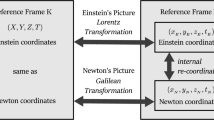Summary
A definition of a freely moving mass in general relativity is proposed based upon properties of the analogous motion in special relativity. Co-ordinate ambiguities can, to a large extent, be removed with the use of «invariant» quantities which play the role of «gauge invariants» in general relativity under co-ordinate transformations which do not change the frame of reference. The gravitational «force» which a freely moving source, taken to be a Schwarzschild mass, exerts on a test mass momentarily at rest, or on another mass momentarily at rest asymptotically far away is calculated, showing that two-body effects can be important even in the case of a «test» mass. The definition of a freely moving mass is shown to be physically meaningful to terms of second order. The calculation has close similarities to that for the analogous motion of a freely moving charge in electrodynamics, renforcing the idea that a restricted set of co-ordinate transformations in general relativity corresponds to the gauge transformations of electrodynamics in special relativity.
Riassunto
Si propone una definizione nella relatività generale di una massa che si muove liberamente basata su proprietà del moto analogo nella relatività speciale. Si possono per lo più eliminare le ambiguità nelle coordinate facendo uso di quantità «invarianti» che svolgono nella relatività generale il ruolo di «invarianti di gauge» rispetto a trasformazioni di coordinate che non cambino il sistema di riferimento. Si calcola la «forza» gravitazionale esercitata da una sorgente che si muove liberamente, supposto che sia una massa di Schwarzschild, su una massa campione momentaneamente in quiete, o su un’altra massa momentaneamente in quiete in posizione asintoticamente lontana e si mostra che gli effetti dei due corpi possono essere importanti anche nel caso di una massa «campione». Si dimostra che la definizione di massa che si muove liberamente ha significato fisico fino ai termini di secondo grado. Il calcolo presenta delle strette somiglianze con quello per il moto analogo di una carica che si muove liberamente in elettrodinamica, il che rafforza l’idea che un insieme ristretto di trasformazioni delle co-ordinate nella relatività generale corrisponde alle trasformazioni di gauge dell’elettrodinamica nella relatività speciale.
Резюме
Предлагается определение свободно движущейся массы в общей теории относительности, которое основано на свойствах аналогичного движения в специальной теории относительности. Координатные неоднозначности могут быть, в значительной степени, удалены с помощью инвариантных величин, которые играют раль «калибровочных инвариантов» в специальной теории относительности при преобразованиях координат, которые не меняют системы отсчета. Вычисляется гравитационная «сила», которая действует со стороны свободно движущегося источника, массы Шварцшильда, на пробную массу, которая в данный момент покоится, или на другую покояшуюся в данный момент массу, находяшуюся на асимптотически большом расстоянии. Показывается, что двухчастичные эффекты могут быть существенны даже в случае «пробной» массы. Отмечается, что это определение свободно движущейся массы имеет физический смысл в виде функции второго порядка. Вычисление оказывается аналогичным вычислению движения свободно движущегося заряда в электродинамике. Это подтверждает гипотезу, что бграниченная система преобразований координат в общей теории относительности соответствует калибровочным преобразованиям электродинамики в специальной теории относительности.
Similar content being viewed by others
References
F. Salzman andG. Salzman:Lett. Nuovo Cimento,1, 859 (1969).
S. Weinberg:Gravitation and Cosmology (New York, N. Y., 1972).
F. A. E. Pirani:Proc. Roy. Soc.,252 A, 96 (1959).
L. D. Landau andE. M. Lifshitz:The Classical Theory of Fields, III Edition (Oxford, 1971), p. 307.
F. A. E. Pirani:Phys. Rev.,105, 1089 (1957).
C. Møller:The Theory of Relativity, II Edition (Oxford, 1972), p. 267, 268, 281.
L. D. Landau andE. M. Lifshitz:The Classical Theory of Fields, III Edition (Oxford, 1971), p. 331.
Author information
Authors and Affiliations
Additional information
Traduzione a cura della Redazione.
Переведено редакцией.
Rights and permissions
About this article
Cite this article
Salzman, F. Gravitational field of a freely moving mass. Nuov Cim B 24, 157–188 (1974). https://doi.org/10.1007/BF02725955
Received:
Published:
Issue Date:
DOI: https://doi.org/10.1007/BF02725955




